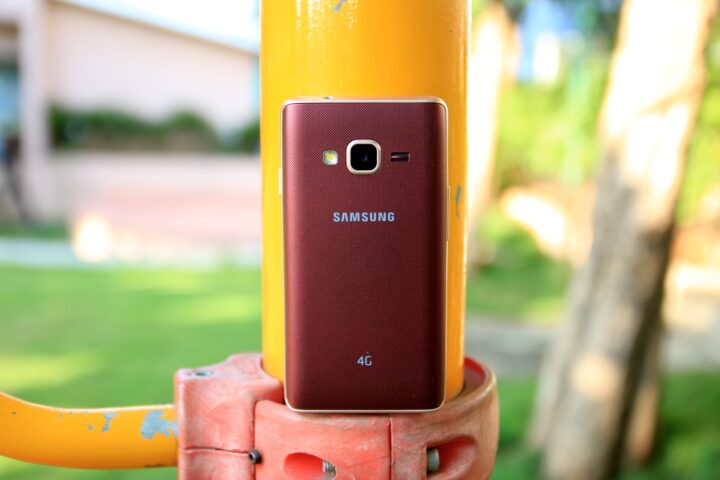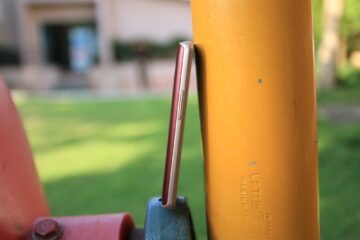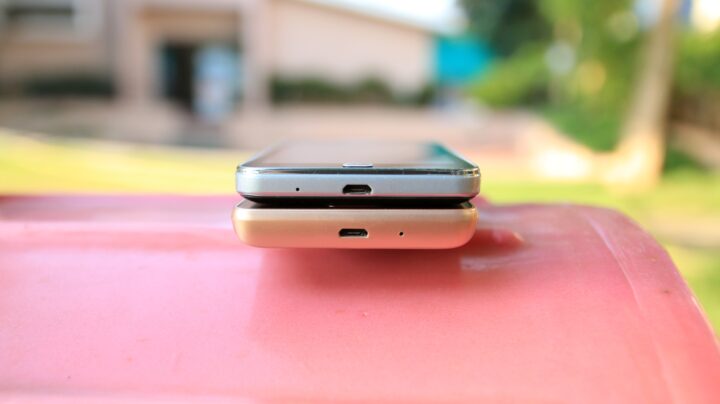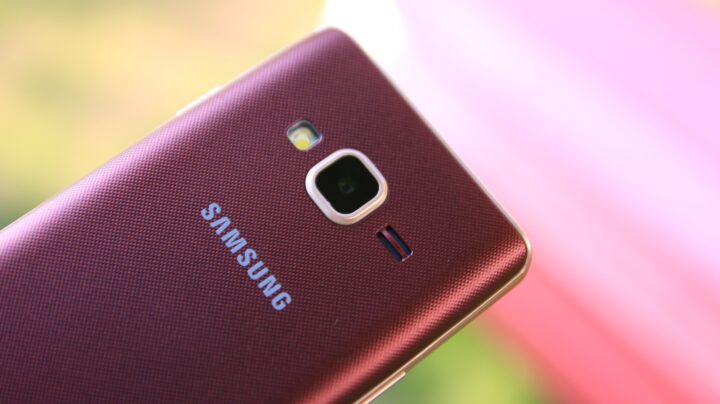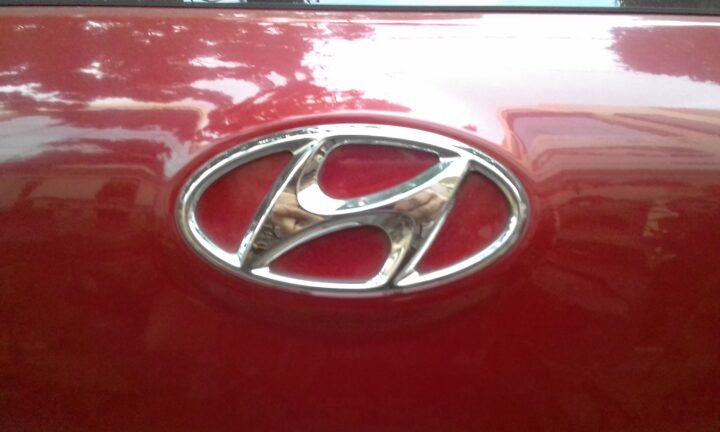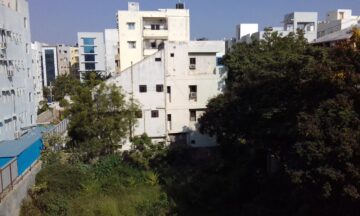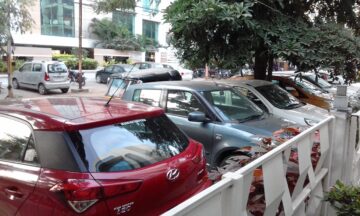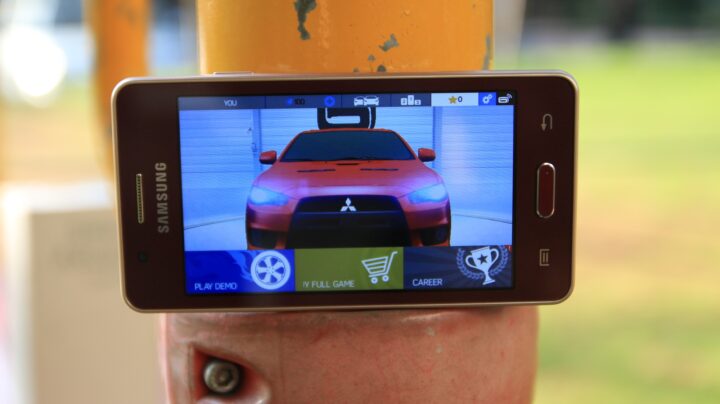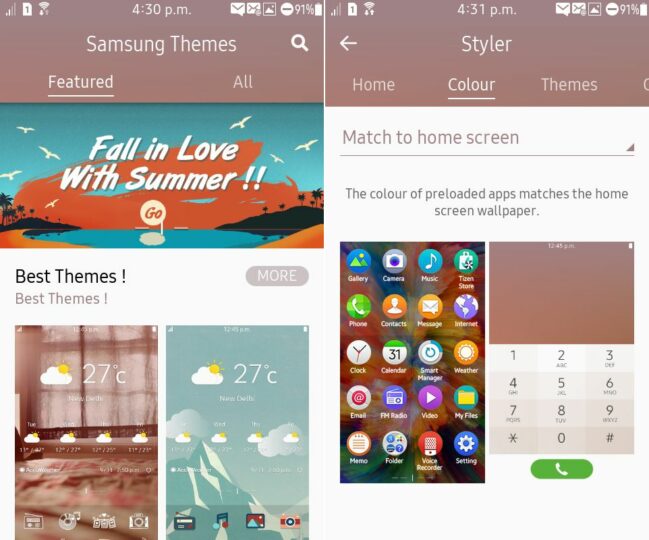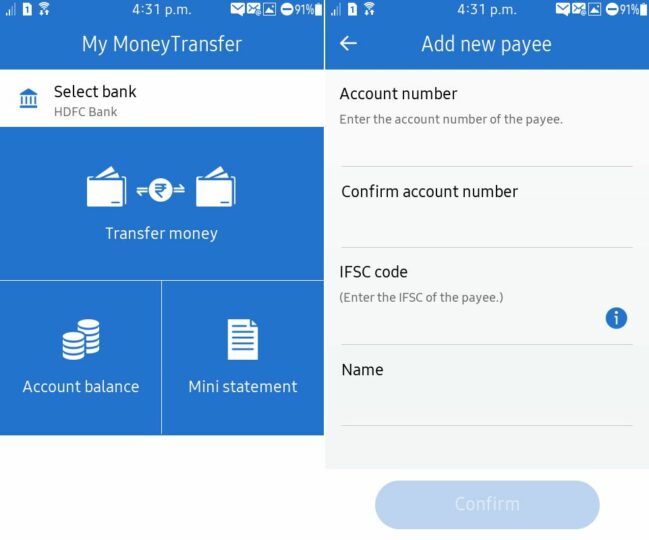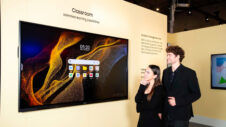Samsung has never been shy about admitting that its Tizen devices are aimed primarily at those moving from a feature phone to a smartphone. The Samsung Z1 and Samsung Z3, the first and second commercial Tizen handsets, came in at the low end of the budget segment, with the Z1 priced at Rs. 5,700 – roughly $85 – in the Indian market. But the Korean giant apparently didn't think it had gone low enough on the price ladder, so here in 2016, Samsung decided to launch the Z2 with a Rs. 4,590 ($68) price tag.
The Samsung Z1 was an extremely low-end device, but the Z2 gets a couple of upgrades despite its lower price. Well, the AMOLED displays that made the Z1 and Z3 compelling have been replaced by an LCD unit here, but there's more RAM, more internal storage, a higher-resolution rear camera and support for 4G LTE connectivity compared to the Z1. It's closer to the Z3 in terms of specs, thanks to the fact that basic smartphone technology has gotten much cheaper since the Z1 hit the market back in 2014.
Also Read: Samsung Z1 Review | Samsung Z3 Review
The star of the show, once again, is Samsung's Tizen operating system. In the two years since it made its way into a commercial smartphone, Tizen has taken numerous steps to being more feature rich compared to what it offered in its initial version. But with the Z1 and Z3, the lack of apps was a bigger problem than features of the OS itself; over the last year or so we have seen a few popular apps get native versions for Tizen, but we're not sure exactly how the app situation is at the moment.
Of course, that is one of the questions that will be answered in this review of the Samsung Z2. We will also be answering some of the questions you put asked us about the Z2 on Facebook at the end of the review, so without further ado, let's get started.
Design
A thick, fat rectangular slab. That's the perfect way to describe the Samsung Z2's build and design. The Samsung Z1 and Z3 weren't exactly high scorers on the thinness scale, but the Z2 is considerably thicker than either of its predecessors (maybe the Z3 should be called its successor, based on the naming scheme?). But the thickness is an advantage here, as it makes the small 4-inch display easier to use. It's all standard fare in other aspects, with the buttons and ports placed in the same locations as on other Samsung phones.
Despite the low price, Samsung seems to have given high attention to the red wine version of the Z2, which is the one we used for our review. It's a two-tone color scheme similar to the Blue Coral Note 7 – the phone is painted gold around the sides, and red on the front and back. It's more like a dark shade of maroon, but it looks fantastic in my opinion, especially when you consider the price tag. The overall build quality of the phone is also good, as befits a device from Samsung (which reigns supreme when it comes to design finesse in the Android world, not counting the explosive nature of the Galaxy Note 7).
Display
The Z2 is the first Tizen device to feature an LCD display and not one of Samsung's Super AMOLED panels. It makes the Z2 something of a lesser proposition, as even on the budget end of the segment, the company's AMOLED displays are far better than the liquid crystal variety. The Z2's display looks a bit washed out, especially at the highest brightness levels. It's not exactly bad, but the colors aren't very punchy and the blacks aren't, well, entirely black. The high brightness levels are one good thing about this display. There's a noticeable color shift when you view the display from an angle, but it's not an issue in general usage. Like other budget Samsung phones, there's no ambient light sensor and therefore no auto brightness option, with just an Outdoors mode for when you need that extra light.
At a price lower than $70, we shouldn't really be complaining about the lack of an AMOLED display here, but I can't help but think that Samsung should have stuck to its in-house panels on a phone that runs its homegrown operating system and, as a result, can be launched at prices lower than devices running Android. But maybe this is a price range Samsung just couldn't go down to for its AMOLED displays, and for first-time smartphone users the Z2's display should be more than sufficient.
Cameras
I'll keep it short and to the point here: The Z2 has cameras only to fill out the basic purpose of clicking a few pictures every now and then. The rear camera is a 5-megapixel fixed-focus sensor that takes very average photos and also finds it hard to focus on close-up objects. Noise is hard to spot in bright natural light, but there is next to no detail when you zoom in on an image. Also, the parts of a scene in shadow tend to come out extremely dark. Thankfully, Samsung offers a slew of shooting modes, including one for fast moving objects and a night mode to bring out a bit more light in dimly lit places. There's also a beauty mode for the rear camera, a Pro mode for changing things like exposure and white balance, and the option to shoot panoramas.
The camera on the front is a measly VGA sensor, and quality is as poor as one would expect. There's considerable noise (unless you're taking photos out under the sun) and images come out extremely soft. However, thanks to the low resolution, the camera manages to capture and save images very quickly. You can also launch the camera app quickly at any moment by pressing the home button twice. Like most of Samsung's recent budget phones, the Z2 comes with a wide selfie mode – this is basically panorama for the front camera and lets you move the phone around to capture a wider scene/fit more people in the frame.
Battery Life
With a 1,500 mAh battery, the Z2 manages to get through the day on a single charge, unless you use the phone a lot on a 4G LTE connection. I'm not actually sure how good the battery life will be with continued usage, as the lack of my favorite apps meant I didn't use the Z2 as I would use an Android device. Idle battery drain also seems a bit high with a single SIM card, especially for a low-end device such as this. There were times when the phone would remind me to charge the battery while I was expecting it to go on a few more hours sitting idle.
Being a Samsung device, you get the Ultra Power Saving Mode (UPSM) for putting the phone in reserve mode. UPSM disables all network connections (Wi-Fi and mobile data) when the screen goes off, and only lets you operate basic apps like the dialer, messages, browser, calculator and clock. You can, however, enable WhatsApp or Facebook as well, and also the voice recorder app. With this mode enabled the phone can last almost twice as long as it would with UPSM off, although the battery endurance of the phone was good enough to never make me reach for the battery saving mode.
Performance
The Samsung Z2, for its price tag, runs impressively well. Stutters in regular usage are hard to come by; there's a lag of a second between the moment you click on an app icon and the moment when the app actually starts up, but slow app launching speeds are to be expected on such a low-end device. However, there is barely any stutter or lag once an app fires up, which is pretty good given the meager hardware inside the phone. I should note that inbuilt apps, like the music player or clock, start up faster than third-party apps.
The Z2 also does well at games. Temple Run 2 and Plants vs Zombies run as smooth as butter, and so does Asphalt Nitro (a demo version of which comes preloaded on the Indian variant of the device). These are what you would call basic games (Asphalt Nitro is a simpler version of the graphics-heavy Asphalt 8 for iOS and Android, although Asphalt 8 is available on Tizen as well), but they are also the more popular titles among smartphone users, so it's good to see the Z2 can run them so well.
Call quality on the Z2 is slightly above average. I never had issues hearing what the person on the other end of the call was saying, although the call volume could do with being a little louder. The loudspeaker, thankfully, isn't so quiet, so you can enjoy your media without reaching for the earphones in a not-so-noisy environment. Samsung's in-box earphones are quiet run of the mill, with next to no focus on the low frequencies (bass), but nothing else should be expected from such an affordable device.
Software
The Z2 runs version 2.4 of Tizen out of the box, and at first glance, not much has changed from the initial versions of the operating system. Unsurprisingly, Tizen's user interface takes after Samsung's TouchWiz IX on Android, although there are many differences in how things work. For one, on the home screen, you access all your apps by swiping up from the dock at the bottom (the dock holds eight app shortcuts which are customizable) instead of pressing a button as you do on Android. There's no multitasking key, so accessing your currently running apps is done by long pressing the home button.
With the Z2, Samsung has also added a nice little gesture for switching between two apps – you can swipe up from the bottom edge of the screen to go back to the last app you were using, and back again to your current one with another swipe. Tizen's light nature means the phone also holds quite a few apps in memory at a time, although after having used Android for so long, having to press the home button to access the multitasking screen feels very cumbersome.
A lot of features seen on Samsung's budget Android devices are present on the Z2. There's Ultra Data Saving Mode for compressing data in order to save data costs, S Bike mode for disabling the phone from receiving calls when you're riding a bike (you can get a full rundown of how S Bike mode works in this post), and Private Mode for securing your media and other files. There's also a theme store for downloading third-party themes and changing the look of the interface; Tizen can change the look of inbuilt apps based on your home screen or lock screen wallpaper.
The Z2 also has a feature that can only be found on Samsung's flagship Android phones. It's called Game Tuner (at least on Android), and it lets you limit the frame rate of a game to save battery power, disable the back and menu keys so that you don't accidentally press them when you're playing a game, and disable all alerts and notifications.
For Indian users, the Z2 also comes preloaded with the My Money Transfer app for allowing money transfer between different bank accounts, without the need of an internet connection. It's a service third-party apps already provide on Android and it works well, although the app does require you to enter important account details for each person you want to send money, making it similar to dedicated banking apps. The good thing is that it works through SMS when you aren't connected, and that is perhaps the only advantage with My Money Transfer.
Apps
Apps are important for every smartphone platform, so we decided to dedicate an entire section to apps in this review. First, let me start by saying that Tizen's app problem has been somewhat alleviated in the two years since the Z1 was released. Popular apps like Facebook, Facebook Messenger, WhatsApp, TrueCaller, MX Player, ShareIt and a few others are now available as native apps on Tizen, in addition to a few India-specific apps like Flipkart, banking apps for HDFC and ICICI, taxi booking app Ola, and others.
But there are also quite a few popular apps missing, including Instagram and Snapchat, all of Google's offerings except a basic search app, and even something as important as Uber. Furthermore, a few apps are simply shells for the web versions of their respective services, so they are also slower compared to actual apps. These apps also fall behind in terms of functionality compared to their Android counterparts. For example, WhatsApp doesn't currently support chat backup and restore. App integration across different apps is also lacking. The best example for this is how Messenger can't detect if you already have your Facebook account logged in on the Facebook app, and you can't sign up in apps using a Gmail or even Samsung account already in use on the device.
It's not surprising as Tizen just isn't widespread enough to be important for app developers, but the lack of apps certainly stands to be the biggest obstacle for Samsung's homegrown mobile OS. A huge reason for the lack of developer interest in Tizen is the fact that Samsung has launched its Tizen smartphones in only a handful of countries. The U.S., the largest market for smartphone apps, isn't on the list yet, so it could be a long time before Tizen gets anywhere close to the app ecosystem enjoyed by Android and iOS.
Before we reach the conclusion, here are answers to a few questions our readers posted on our Facebook page:
Q1: On a scale from Android to ios, how well optimized is Tizen?
A: It's not as good as iOS, but Tizen is certainly more optimized than Android, especially for low-end hardware. The Z2 runs quite well as I explained in the performance section above, and it would be interesting to see just how well it would do on more powerful devices.
Q2: Battery consumption compared to android and how is the app store if have any.
A: Battery consumption is where Tizen acts more like Android than iOS. Battery life on the Z2 isn't bad, but it's not really as good as one would expect from such an optimized OS. It's probably because Tizen has true background multitasking like Android. As for the app store, please read the apps section above to get an idea of where Tizen stands on the apps front.
Q3: How many useful apps can I get on this Tizen-powered device? It would be great if android app can be installed on it.
A: Please read the apps section of the review for the first part of this question. For the second, well, Tizen doesn't allow the user to install Android apps, although a third-party service does let you run Android apps as long as the app's developer adds support for that service.
Q4: Will the battery explode?
A: Now that's a question we can't really answer. Any smartphone can explode owing to many different factors, but the Z2 (or any other current Samsung device) shouldn't be as explosion-prone as the Galaxy Note 7, which clearly suffers from a hardware flaw.
Wrap Up
For a smartphone that costs less than $70, the Z2 is quite impressive. It has a good build (with an excellent color option in the red wine variant), the software is rather smooth and fast, and it offers 4G LTE connectivity at a very low price. As one would expect, though, apps are what make the Z2 a poor proposition. Too many popular apps are missing, and a lot of available apps aren't as feature-rich as their Android or iOS (or even Windows Phone) versions. It's a problem that most likely won't go away in the foreseeable future, thanks to the fact that Android and iOS are pretty much ensconced as the only viable smartphone platforms.
At the end of the day, the Z2 remains a good choice for those moving on from a feature phone and for those who are looking for a secondary phone for calls and other basic use cases (the support for 4G LTE networks means you can use it as a tethering device). There are no comparable Android phones from a well known manufacturer out on the market in this price range, but it would be better to just save up and grab an Android device instead of limiting oneself with a Tizen smartphone.
| Pros | Cons |
| Good build quality | Tizen lacks too many important apps |
| Compact, easy to handle size | LCD display isn't very impressive |
| Impressive performance despite the low-end hardware | Average audio quality |
| 4G LTE support on a budget | Poor cameras |
| Phone lasts a day with regular usage | Screen size can be a tad too small at times |

